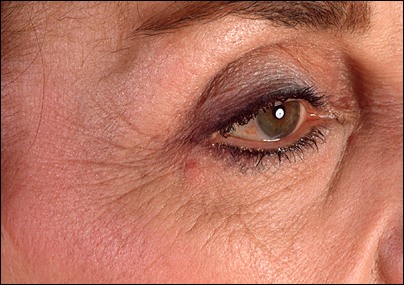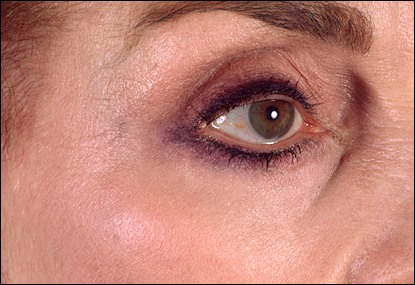 |
|---|
หน้าหลัก | สุขภาพดี | สุภาพสตรี | การแปลผลเลือด | โรคต่างๆ | วัคซีน
สารเคมีที่ใช้ในการลอกหน้า
สารเคมีที่ใช้ในการลอกหน้ามีด้วยกันหลายชนิด แต่ละชนิดก็มีความรุนแรงต่างกัน มีโรคแทรกซ้อนต่างกัน การศึกษาคุณสมบัติของสารเคมีที่ใช้ในการลอกหน้า จะช่วยให้ท่าน ได้ประโยชน์จากการลอกหน้า

รอยย่นก่อนลอกหน้า |

รอยย่นจางลงหลังลอกหน้า |
การใช้กรดผลไม้ในการลอกหน้า
- Jessner's Peel ใช้ลอกหน้าชนิดปากกลาง ลอกหน้าได้ลึกกว่ากรดผลไม้ สารนี้ประกอบด้วย salicylic acid (BHA), lactic acid (AHA) และ resorcinol แพทย์จะทากรดผลไม้เพื่อให้หน้าท่านสะอาด หลังจากนั้นจะทา Jessner's Peel ท่านอาจจะรู้สึกปวดแสบบริเวณที่ทาซึ่งอาจจะบรรเทาโดยการใช้พัดลมช่วยเป่า หลังจากล้างเอาครีมออก ใบหน้าท่านจะมีสีขาว และเปลี่ยนเป็นสีแดง เมื่อหายแล้วผิวหน้าจะดูดีขึ้น
- The Obagi Blue Peel ส่วนประกอบที่สำคัญคือ trichloracetic acid (TCA) ใช้ลอกหน้าในรายที่มีรอยตื้นๆ ผิวตกระไม่มาก ระหว่างการลอกหน้าจะมีอาการปวดแสบร้อนเหมือนกัน
- Phenol เป็นสารเคมีที่มีความเป็นกรดมากที่สุด ใช้ลอกหน้าชนิดลึก การลอกหน้าชนิดนี้จะมีอาการปวดแสบมากกว่าชนิดอื่น จำเป็นต้องใช้ยาชาและยากล่อมประสาทแพทย์จะต้องตรวจวัดความดันและการเต้นของหัวใจในระหว่างการลอกหน้า หลังการลอกหน้าชนิดนี้ห้ามไปตากแดดเพื่อให้ผิวเข้มขึ้น การลอกหน้านี้ให้ใช้เฉพาะใบหน้าเท่านั้นหากใช้บริเวณอื่นอาจจะทำให้เกิดแผลเป็นได้ง่าย จะใช้ลอกหน้าสำหรับผู้ที่มีรอยโรคลึก เช่น รอยย่นลึก แผลเป็น ผิวหนังจะเริ่มสร้างใหม่ใน 10 วันช่วงแรกผิวจะมีสีแดงและจะกลายเป็นสีชมพูในหลายสัปดาห์-หลายเดือนเป็นต้น
ข้อบ่งชี้ในการใช้
ข้อแนะนำในการใช้
ข้อที่ควรจะต้องพิจารณา
ข้อควรปฏิบัติหลังการลอกหน้า
หลังการลอกหน้าจะมีความรู้สึกแสบร้อนและบวมบริเวณใบหน้าอย่ายิ้ม อ้าปาก หรือการแสดงออกบนใบหน้ามากเกินไปเพราะอาจจะทำให้เกิดการฉีกขาดของผิวหนัง และเกิดแผลเป็น ข้อควรปฏิบัติหลังการลอกหน้า
|
ข้อห้ามใช้สารเคมีในการลอกหน้า
Overview
A chemical peel is a procedure in which a chemical solution is applied to the skin to remove the top layers. The skin that grows back is smoother. With a light or medium peel, you may need to undergo the procedure more than once to get the desired results.
Chemical peels are used to treat wrinkles, discolored skin and scars — usually on the face. They can be done alone or combined with other cosmetic procedures. And they can be done at different depths, from light to deep. Deeper chemical peels offer more-dramatic results but also take longer to recover from.
Products & Services
Why it's done
A chemical peel is a skin-resurfacing procedure. Depending on the issues you're addressing with the procedure, you'll choose a chemical peel in one of three depths:
Chemical peels can't remove deep scars or wrinkles or tighten sagging skin.
Risks
A chemical peel can cause various side effects, including:
A chemical peel isn't for everyone. Your doctor might caution against a chemical peel or certain types of chemical peels if you:
How you prepare
Choose a doctor with knowledge of the skin and procedure — a dermatologist or dermatologic surgeon. Results can be variable and depend on the expertise of the person doing the peel. Improperly done, a chemical peel can result in complications, including infection and permanent scars.
Before you have a chemical peel, your doctor will likely:
Before your peel, you might also need to:
What you can expect
Before the procedure
A chemical peel is usually done at an office or in an outpatient surgical facility. Before the procedure, your doctor will clean your face, protect your hair, and cover your eyes with ointment, gauze, tape or goggles.
Pain relief isn't typically needed for a light chemical peel. If you're having a medium peel, you might receive a sedative and painkiller. For a deep peel, you might have a sedative, something to numb the treatment area and fluids delivered through a vein.
During the procedure
During a light chemical peel:
During a medium chemical peel:
During a deep chemical peel:
After the procedure
After a chemical peel of any depth, your skin will be red, tight, irritated or swollen. Follow your doctor's directions for sun protection, cleansing, moisturizing and applying protective ointments to your skin. And avoid picking, rubbing or scratching your skin. It may take several months before your skin color returns to normal and you can see the full results of the peel.
After a light chemical peel, treated skin will be red, dry and mildly irritated — although these effects might be less noticeable with each repeat treatment. Your doctor might apply a protective ointment, such as petroleum jelly, to soothe the skin. You can usually wear makeup the next day if you wish.
Treated areas take about one to seven days to heal after a light chemical peel. New skin might temporarily be lighter or darker than normal.
After a medium chemical peel, treated skin will be red and swollen. You'll feel stinging. Your doctor might apply a protective ointment, such as petroleum jelly, to soothe the area and prevent dryness. After five to seven days, you can use cosmetics to cover any redness.
Use ice packs for comfort. Over-the-counter pain-relieving medication, such as ibuprofen (Advil, Motrin IB, others) and naproxen sodium (Aleve, others), may help reduce any discomfort. You'll likely schedule a checkup soon after your treatment so that your doctor can monitor your healing.
As swelling decreases, treated skin will begin to form a crust and might darken or develop brown blotches. Treated areas take about seven to 14 days to heal after a medium chemical peel, but redness might last for months.
After a deep chemical peel, you'll experience severe redness and swelling. You'll also feel burning and throbbing, and the swelling may even make your eyelids swell shut.
Your doctor will apply a surgical dressing to treated skin. He or she might also prescribe painkillers. You'll need to soak the treated skin and apply ointment several times a day for about two weeks.
Treated areas will develop new skin within about two weeks after a deep chemical peel, although redness might last for months. Treated skin might become darker or lighter than normal or lose the ability to tan.
You might prefer to remain at home while you're healing from a chemical peel. You'll likely need several follow-up visits soon after your treatment so that your doctor can monitor your healing.
Once new skin completely covers the treated area in about two weeks, you can use cosmetics to conceal any redness. Use sunscreen every day.
Results
A light chemical peel improves skin texture and tone and lessens the appearance of fine wrinkles. The results are subtle but increase with repeated treatments. If you have a medium chemical peel, treated skin will be noticeably smoother. After a deep chemical peel, you'll see a dramatic improvement in the look and feel of treated areas. Results may not be permanent. Over time, age and new sun damage can lead to new lines and skin color changes.
With all peels, the new skin is temporarily more sensitive to the sun. Talk with your doctor about how long to protect your skin from the sun.
การลอกหน้า วิธีการลอกหน้า สารเคมีที่ใช้ในการลอกหน้า โรคแทรกซ้อนที่เกิดจากการลอกหน้าอันตรายของครีมหน้าขาว ที่ผสมไฮโดรควิโนน